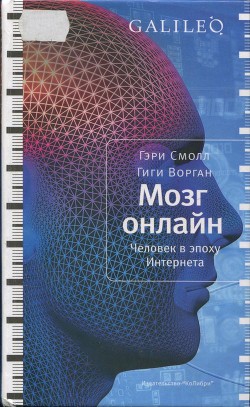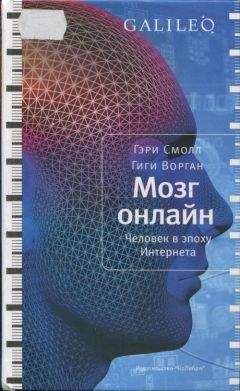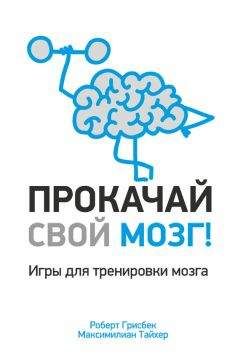Мозг онлайн. Человек в эпоху Интернета - Смолл Гэри

Помощь проекту
Мозг онлайн. Человек в эпоху Интернета читать книгу онлайн
61. AMA Report of the Council on Science and Public Health. Emotional and Behavioral Effects, Including Addictive Potential, of Video Games, www.ama-assn.org/amai/pub/upload/mm/467/csaph12ao7.doc
62. Nicoll J., Kieffer K. M. Violence in video games: A review of the empirical research. American Psychological Association Annual Meeting. August 2005
63. Kawashima R. Train Your Brain: 60 Days to a Better Brain. Kumon Publishing North America, Teaneck, 2005
64. Haier R. J., Siegel B. V., MacLachlan A., et al. Regional glucose metabolic changes after learning a complex visuospatial/motor task: A positron emission tomographic study. Brain Research 1992; 570:134-143
65. Rosser J. C. Jr., Lynch P.J., Cuddihy L, Gentile D. A., Klonsky J., Merrell R. The impact of video games on training surgeons in the 21st century. Archives of Surgery 2007; 142:181-186
66. Green C. S., Bavelier D. Action video game modifies visual selective attention. Nature 2003; 423:534-537
67. Szajlarski J.P., Holland S.K., Schmithorst V. J., Byars A. W. fMRI study of language lateralization in children and adults. Human Brain Mapping 2006; 27:202-212
68. Small G., Vorgan G. The Longevity Bible. Hyperion, New York, 2006
69. Czaja S. J., Charness N., Fisk A. D., et al. Factors predicting the use of technolog у: Findings from the Center for Research and Education on Aging and Technology Enhancement (CREATE). Psychology and Aging 2006; 21:333–352, www.pubmedcentral.nih.gov/articlerender.fcgi?tool=pubmed&pubmedid=16768579
70. Fox S. Digital divisions. Pew Internet & American Life Project. October 5, 2005, www.pewinternet.org/pdfs/PIP_Digital_Divisions_Oct_5_2005.pdf
71. Cohen G. D. The Mature Mind: The Positive Power of the Aging Brain. Basic Books, New York, 2006
72. Cabeza R., Daselaar S. M., Dolcos F., et al. Taskindependent and task-specific age effects on brain activity during working memory, visual attention and episodic retrieval. Cerebral Cortex 2004; 14:364-375
73. Liu Y., Yu C., Liang М., et al. Whole brain functional connectivity in the early blind. Brain 2007; 130: 2085-2096
74. Théoret Merabet L, Pascual-Leone A. Behavioral and neuroplastic changes in the blind: Evidence for functionally rel— evant cross-modal interactions. Journal de Physiologie (Paris) 2004; 98:221-233
75. Burton H., McLaren D.G. Vi— sual cortex activation in late-onset, Braille naive blind individuals: An fMRI study during semantic and phonological tasks with heard words. Neuroscience Letters 2006; 392:38-42
76. Willis S.L, Tennstedt S.L, Marsiske М., et al. Long-term effects of cognitive training on everyday functional outcomes in older adults. Journal of the American Medical Association 2006; 296:2805-2814
77. Velanova K., Lustig С., Jacoby L.L., Buckner R. L. Evidence for frontally mediated controlled processing differences in older adults. Cerebral Cortex 2006; 17:1033-1046
78. Bartzokis G., Lu P.H., Geschwind D. H., et al. Apolipoprotein E genotype and age-related myelin breakdown in healthy individuals: implications for cognitive decline and dementia. Archives of General Psychiatry 2006; 63:63-72
79. Cabeza R., Anderson N. D., Locantore J. K., McIntosh A. R. Aging gracefully: compensatory brain activity in high-performing older adults. Neuroimage 2002; 17: 1394-1402
80. Helson R., Soto C. J. Up and down in middle age: monotonic and nonmonotonic changes in roles, status, and personality. Journal of Personality and Social Psychology 2005; 89:194-204
81. U.S. Census Bureau Resident Population Estimates of the United States by Age and Sex, http://www.census.gov/population/estimates/nation/intfile2-1.txt
82. Ng B.D., Wiemer-Hastings P. Addiction to the Internet and online gaming. Cyberpsychology & Behavior 2005; 8:110-113
83. Di Chiara G., Bassareo V. Reward system and addiction: What dopamine does and doesn’t do. Current Opinion in Pharmacology 2007; 7:69-76
84. Rau P.-LP., Peng S.-Y., Yang C.-C. Time distortion for expert and novice online game players. Cyberpsychology & Behavior 2006; 9:396–403.
85. Nestler E. J., Carlezon W. A. The mesolimbic dopamine reward circuit in depression. Bio— logical Psychiatry 2006; 59:1151-1159
86. Kalivas P. W., Volkow N. D. The neural basis of addiction: A pathology of motivation and choice. American Journal of Psychiatry 2005; 162:1403-1413
87. Worker fired over visit to adult chat room sues IBM. Los Angeles Times (Associated Press). February 19, 2007
88. Craig S., Zuckerman G. BlackBerry addicts also can’t resist this little game. The Wall Street Journal. February 17, 2007
89. Associated Press. Stanford University study warns of Internet Addiction, http://abclocal.go.com/kabc/story?section=local&id=4679518
90. Kanwal N., Anand A.P. Internet addiction in students: A cause of concern. Cyberpsycholog у & Behavior 2003; 6:653-656
91. Goldman D., Orisci G., Ducci F. The genetics of addictions: uncovering the genes. Nature Review Genetics 2005; 6:521-532
92. Leung L. Net-generation attributes and seductive properties of the Internet as predictors of online activitiesand Internet addiction. Cyberpsychology & Behavior 2004; 7:333-347
93. Pham A. Gaming junkies get no diagnosis. Los Angeles Times. June 28, 2007
94. Beard K. W. Internet addiction. A review of current assessment techniques and potential assessment questions. Cyberpsychology & Behavior 2005; 8:7-15
95. Hakala P. T., Rimpela A. H., Saarni L. A., Salminen J. J. Frequent computer-related activities increase the risk
of neck-shoulder and low back pain in adolescents. European Journal of Public Health 2006; 16:536-541
96. Beard K. W. Cyberpsychology & Behavior 2005; 8:7-15
97. Reuters. Twelve-step program aims to cure e-mail addiction, www.reuters.com/article/internetNews/idUSN1943527720070220
98. Rau P.P., Peng S., Yang C. Time distortion for expert and novice online game players. Cyberpsycholog у & Behavior 2006; 9:396—403
99. Lenhart A. Social networking websites and teens: An overview. Pew Internet & American Life Project. January 3, 2007, www.pewinternet.org/pdfs/PIP_SNS_Data_Memo_Jan_2007.pdf
100. Rau et al. Cyberpsychology & Behavior 2006; 9: 396-403
101. Griffiths M. D., Davies M. N. O., Chappell D. Demographic factors and playing variables in online computer gaming. Cyberpsychology & Behavior 2004; 4:479-487
102. Alter A. Is this man cheating on his wife? The Wall Street Journal. August 10, 2007
103. Spink A., Jansen B.J. Web Search: Public Searching of the Web. Berlin: Springer-Verlag, 2004
104. Maltz W., Maltz L The Porn Trap: The Essential Guide to Overcoming Problems Caused by Pornography. HarperCollins, New York, NY, 2008
105. Spink A., Ozmutlu H.C., Lorence D.P. Web searching for sexual information: an exploratory study. Information Processing and Management 2004; 40:113-123
106. Dun and Bradstreet Survey. D&B study shows seven out of 10 U.S. small businesses now have Internet access. May 25, 2000, www.dnb.com/newsview/0500news8.htm

























